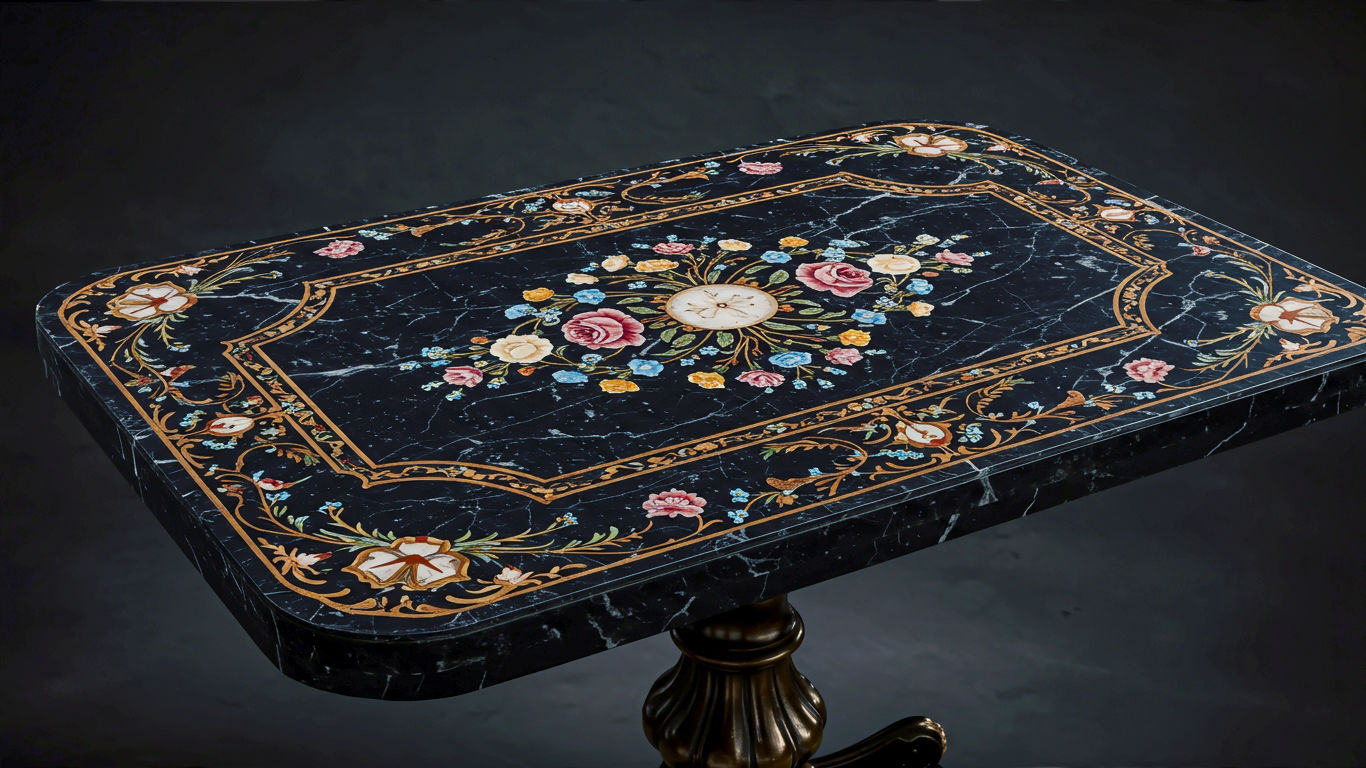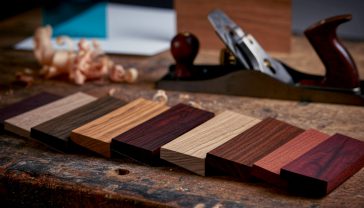The Definitive Guide to Black Marble: From Ancient Stone to British Icon
Uncover the story of black marble. Learn why this famous stone isn’t truly marble and explore its celebrated history as a British decorative art icon.

This post may contain affiliate links. If you make a purchase through these links, we may earn a commission at no additional cost to you.
Ever walked through a grand old British house, a cathedral, or a museum and felt the cool, dark elegance of a polished black stone under your fingertips? Chances are, you’ve met black marble. It’s the stuff of stately fireplaces, gleaming chessboards, and intricate inlays that catch the light just so. It feels ancient, solid, and just a little bit mysterious.
But what exactly is it? The story of black marble isn’t as simple as you might think. It’s a tale that takes us deep underground, back through millions of years of prehistory, and into the hands of skilled British craftspeople who turned this dark stone into a national treasure. From the rolling hills of the Peak District to the halls of Buckingham Palace, black marble is more than just a rock—it’s a piece of Britain’s story, set in stone.
So, let’s dig in. We’ll uncover what makes this material so special, why it’s not always technically marble, and how it became a symbol of Victorian elegance and ingenuity. It’s a journey into the heart of the stone, revealing the fossils, the artistry, and the history locked within its polished, inky depths.
What on Earth is Black Marble? The Great Geological Mix-Up
Here’s the first surprise: most of the stuff we call black marble isn’t actually marble at all. At least, not to a geologist.
To a scientist, true marble is a metamorphic rock. That’s a fancy way of saying it’s a rock that has been completely changed by immense heat and pressure deep within the Earth. Think of it like a lump of dough being baked into bread. The original rock, usually limestone or dolostone, gets squeezed and cooked until its crystals grow and interlock, creating the veined, crystalline patterns we often see in white or coloured marbles like Italy’s famous Carrara marble.
So, what is the stone we call black marble?
A Sedimentary Story: The Real Identity
Most black marble, including the famous varieties from Britain, is actually a type of sedimentary rock. Specifically, it’s a very dense, fine-grained limestone or bituminous limestone.
Let’s break that down:
- Sedimentary Rock: This is rock formed from layers of sediment—like sand, mud, and tiny fragments of shells—that build up over millions of years at the bottom of ancient oceans or lakes. Imagine layers of dust settling in a forgotten room, but on a geological timescale and under the crushing weight of the sea.
- Limestone: This particular sediment is rich in calcium carbonate, which mostly comes from the shells and skeletons of countless tiny sea creatures.
- Bituminous: This is the secret ingredient. The “bitumen” is simply organic material—the decomposed remains of ancient algae, plankton, and other marine life. This carbon-rich gunk got trapped in the layers of sediment. When the sediment was compressed into rock, this organic matter gave the stone its deep, rich black colour.
So, in simple terms, black marble is a polished, fossil-rich black limestone. It’s dark because it’s full of the microscopic remains of ancient life. When you look at a piece of Ashford Black Marble from Derbyshire, you’re essentially looking at the beautifully preserved floor of a 350-million-year-old tropical sea that once covered the Peak District.
Why Call It Marble, Then?
So why the mix-up? The name “marble” has long been used in the stone trade for any limestone that can be cut and polished to a high shine. It’s a commercial term, not a strictly geological one. For centuries, if a stone was beautiful, polishable, and could be used for carving or building, it was often simply called marble. The “black” part is easy—it’s defined by its stunning, dark appearance.
This dense, dark limestone polishes up so beautifully, with a deep, mirror-like finish, that it rivals the elegance of true marbles. So, the name stuck.
The British Black Marble Capital: A Trip to Derbyshire
While black marble is found in various parts of the world, from Belgium to Spain, Britain has its own unique and celebrated variety: Ashford Black Marble. This stone is central to the story of black marble in the UK, and its history is rooted in the landscape of the Peak District.
The Discovery in a Duke’s Land
The story begins in the hills around the village of Ashford-in-the-Water in Derbyshire. For centuries, locals knew of a dark, tough stone that could be dug from the ground. But it wasn’t until the 17th century that its true potential was realised.
Bess of Hardwick, one of the most powerful women in Elizabethan England, is said to have used it in the 16th century for the Grand Staircase at Chatsworth House. However, it was the discovery of its incredible ability to be worked on a lathe and polished to a brilliant shine that transformed it from a local building material into a prized decorative stone.
The main source was Arrock Mine, and later Sheldon Moor, near Ashford. The stone extracted here was exceptionally fine-grained and a deep, consistent black, with very few distracting fossils or veins. This purity made it perfect for intricate work.
From Local Craft to Royal Favour
The turning point for Ashford Black Marble came in the 18th century. A local man named Henry Watson realised that the stone could be turned on a lathe, much like wood, to create beautiful objects like urns, columns, and cups. He established a water-powered mill at Ashford-in-the-Water in 1748, kicking off a local industry.
The real boom, however, was in the Victorian era. Queen Victoria herself became a great admirer. After the death of her beloved Prince Albert in 1861, the nation was plunged into a period of deep mourning. Black became the colour of fashion, jewellery, and decorative arts. Ashford Black Marble, with its sombre and dignified beauty, was the perfect material for the time.
It was used for everything from grand chimneypieces to delicate mourning jewellery, like brooches and pendants. The industry thrived, with workshops in towns like Buxton, Matlock, and Castleton producing exquisite pieces for a global market.
The Art of Inlay: Pietra Dura, Derbyshire Style
The Victorians weren’t content with just plain black. They perfected a stunning decorative technique called pietra dura, an Italian term meaning “hard stone.” This is the art of creating intricate pictures or patterns by inlaying precisely cut pieces of coloured stones into a solid background.
Think of it as jigsaw puzzles for artists, but with stone.
A Local Twist on an Italian Art Form
While the Florentines in Italy were the original masters of pietra dura, Derbyshire craftsmen developed their own unique style. Instead of the brightly coloured agates used in Italy, they used local stones and minerals to create their designs, set against the perfect jet-black canvas of polished Ashford Black Marble.
The process was incredibly painstaking:
- Sourcing the Colours: Craftsmen would scour the Derbyshire dales for colourful local minerals. They used yellow from a stone called ‘Duke’s Red’, grey from a type of limestone, blue and purple from the iconic Blue John fluorspar, and green from local minerals.
- Slicing and Shaping: The coloured stones were sliced into thin veneers, just a few millimetres thick. These were then carefully cut into the required shapes for the design—often delicate flower petals, leaves, or birds.
- Inlaying: The design was engraved into the surface of the black marble. The craftsman would then excavate a shallow recess for each piece of the inlay. Each coloured stone shape had to fit perfectly into its slot.
- Sticking and Polishing: The pieces were fixed in place with a special cement made from resin. The whole surface was then ground down to be perfectly level and polished with a series of finer and finer abrasives until it shone like glass. The final polish, using a substance called ‘putty powder’, brought out the deep, lustrous black of the marble and the vibrant colours of the inlay.
The most common motifs were floral designs, especially local English flowers like roses, forget-me-nots, and lilies of the valley. These beautiful, sentimental designs were hugely popular with Victorian tourists who visited the Peak District and wanted a sophisticated souvenir to take home. Tabletops, jewellery boxes, inkstands, and paperweights decorated in this way became the height of fashion.
More Than Just a Stone: Black Marble in Architecture and Culture
Beyond decorative objects, black marble has long been used in architecture to convey a sense of power, solemnity, and luxury. Its deep colour provides a dramatic contrast with lighter stones, creating striking visual effects.
A Symbol of Grandeur
In the UK, you can find black marble used as a flooring material in cathedrals, creating checkerboard patterns with white marble. This contrast wasn’t just decorative; it was symbolic, representing light and dark, good and evil.
Many stately homes feature grand fireplaces made from polished black marble. Its dark, reflective surface would have beautifully mirrored the flickering firelight, creating a warm and imposing centrepiece for a room. Kedleston Hall in Derbyshire, for example, has a magnificent fireplace made by Joseph Hall of Derby, showcasing the stone’s dramatic potential.
Memorials and Monuments
Because of its sombre and enduring nature, black marble has often been chosen for memorials. It provides a dignified and permanent background for engraved lettering, making it a fitting choice for honouring the dead or commemorating important events. The contrast between gilded or white lettering and the dark stone is both legible and visually powerful.
Walk through many old British churches, and you’ll find memorial plaques made of black marble, their inscriptions still sharp and clear after centuries.
The Decline and Legacy of a British Industry
So, what happened to the thriving Derbyshire black marble industry? By the late 19th century, its popularity began to wane. Victorian tastes changed, and the fashion for mourning jewellery and elaborate decoration faded.
Worse, cheaper imports of black marble from countries like Belgium became available. The industry also faced a shortage of the highest-quality raw material, as the best seams at Arrock Mine were worked out. By 1905, the last of the major workshops had closed, and the craft of Ashford Black Marble inlaying all but disappeared.
A Lost Art Rediscovered
For much of the 20th century, the skills of the Derbyshire craftsmen were largely forgotten. However, the legacy of their work lives on in museums and private collections around the world. The Buxton Museum and Art Gallery holds a fantastic collection of Ashford Black Marble items, showcasing the incredible artistry of the Victorian makers.
In recent years, there has been a renewed interest in this unique British craft. A few dedicated artisans are now working to revive the old techniques, sourcing original materials and creating new pieces inspired by the Victorian masters. The stone itself is no longer commercially mined, making original pieces even more precious.
The story of Ashford Black Marble serves as a reminder of how regional geology and local craftsmanship can come together to create something of national and even international importance.
How to Spot and Care for Black Marble
Today, black marble is still used in modern design, often for kitchen worktops, bathroom tiles, and high-end furniture. However, these are typically imported stones. If you have an antique piece, it might just be a genuine piece of British history.
Identifying Antique Black Marble
- Look for the Inlay: The most distinctive feature of Derbyshire pieces is the pietra dura inlay of flowers or birds.
- Feel the Weight and Cold: Like any stone, it will be heavy and cool to the touch.
- Check for a Deep, Lustrous Shine: The polish on old Ashford marble is famously deep and mirror-like. It shouldn’t look like a modern, plasticky spray-on finish.
- Imperfections: It’s a natural material. You might see tiny, faint fossils or mineral lines if you look very closely, though the best pieces are a pure, uniform black.
Caring for Black Marble
Whether it’s an antique table or a modern countertop, black marble needs a bit of care to keep it looking its best.
- Avoid Acids: This is the golden rule. Because it’s a limestone, black marble is vulnerable to acids. Spills like lemon juice, vinegar, or wine can etch the surface, leaving a dull, whitish mark. Wipe up any spills immediately.
- Clean Gently: Use a soft cloth with warm water and a pH-neutral cleaner. Avoid abrasive scouring powders or harsh chemical cleaners, as they can scratch the polish.
- Protect the Surface: Use coasters under glasses and mats under hot dishes. On a worktop, always use a chopping board.
- Sealing: Modern black marble countertops are often sealed to help resist staining. This sealant may need to be reapplied periodically.
The Enduring Allure of Black
So, what does the term black marble mean?
On the surface, it’s a beautiful, dark stone, prized for its ability to take a high polish. Geologically, it’s a window into an ancient world, a limestone packed with the carbon remains of prehistoric sea life.
But in Britain, it means something more. It represents a unique story of regional craft, Victorian innovation, and the transformation of a humble local stone into a symbol of elegance and sentiment. It’s a material that connects us to the deep history of our landscape and to the skilled hands that shaped it.
The next time you see a polished black fireplace or a delicate inlaid box, take a closer look. You’re not just looking at a decorative object. You’re looking at a piece of the Peak District, a slice of Victorian culture, and a testament to a craft that turned ancient darkness into timeless beauty.
Further Reading
To explore this topic further, here are some highly respected resources:
- Buxton Museum and Art Gallery: Home to the leading public collection of Ashford Black Marble. Their website and exhibits offer a deep dive into the craft and its history.
- The Peak District National Park Authority: Provides geological and historical information about the region where Ashford Black Marble was sourced.
- The Geologists’ Association: Offers articles and resources on British geology, including the Carboniferous Limestone of the Peak District.
- Victoria and Albert Museum (V&A): Their collections and online resources often feature decorative arts from the Victorian period, including examples of pietra dura and mourning jewellery.






